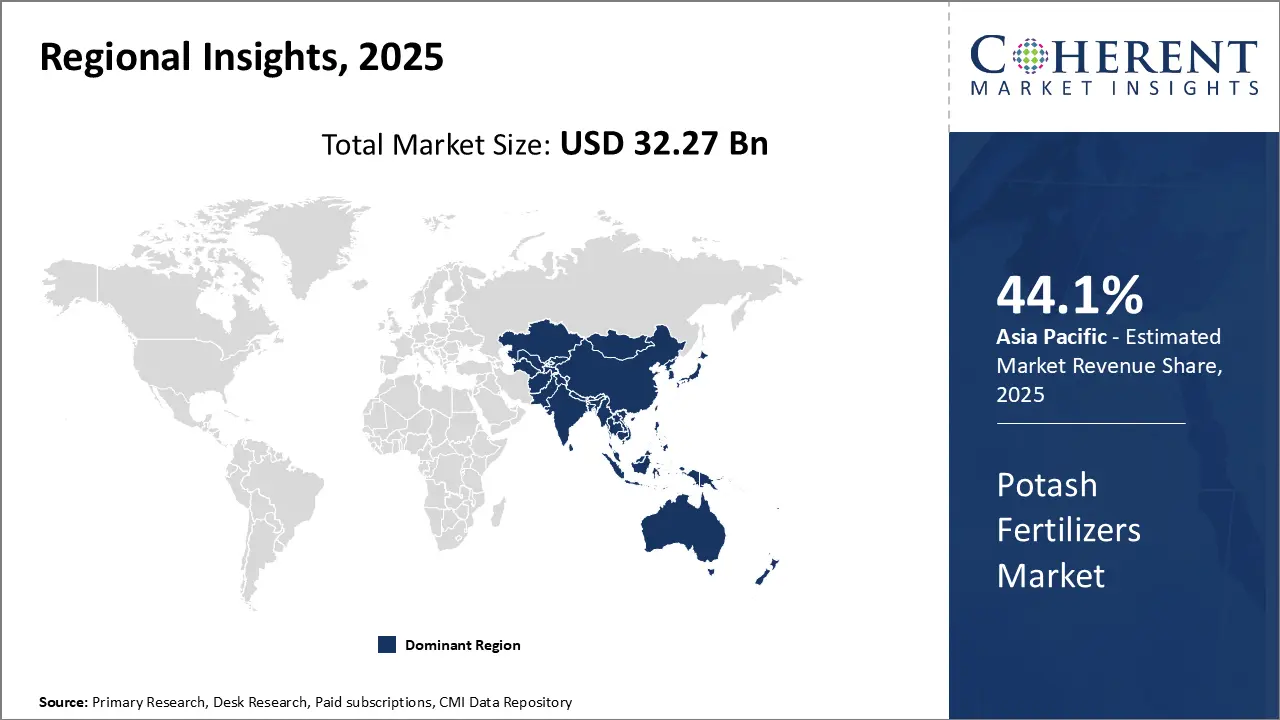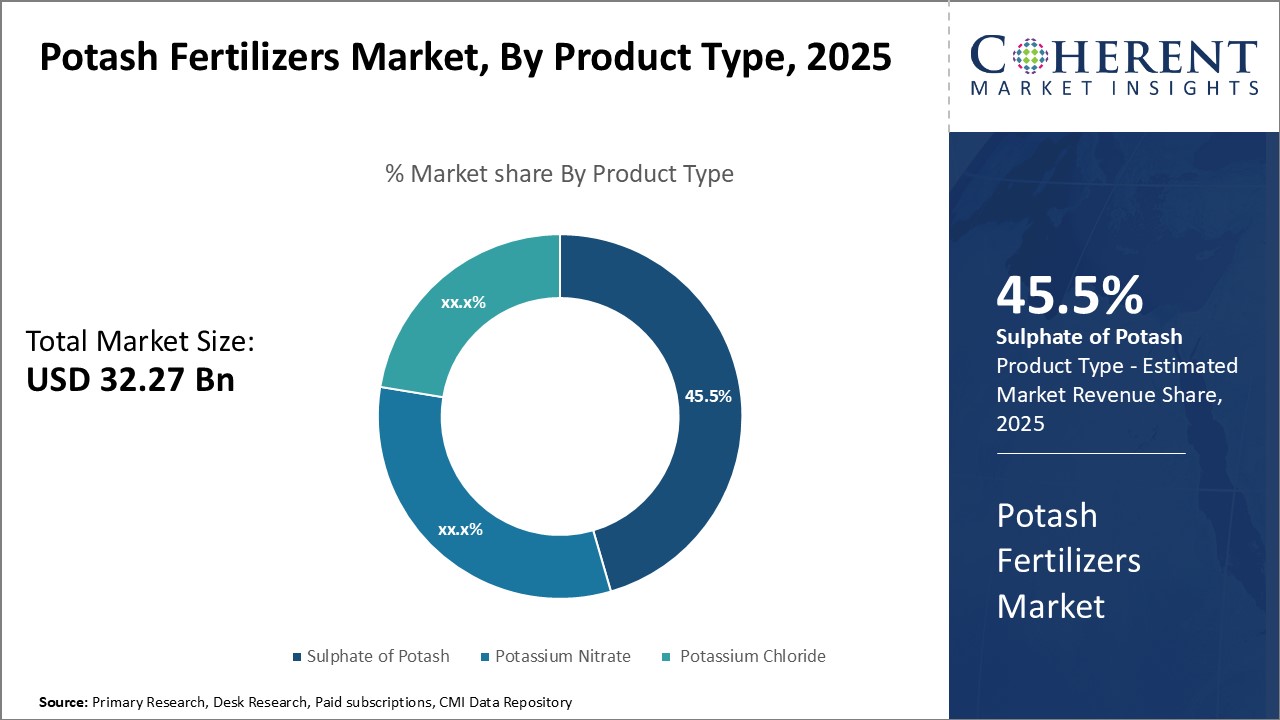Global potash fertilizers market is expected to reach US$ 47.88 Bn by 2032, from US$ 32.27 Bn in 2025, exhibiting a compound annual growth rate (CAGR) of 5.8% during the forecast period (2025-2032).
Potassium (K), which is often referred as Potash, is one of the essential nutrients used in the fertilizer industry. Increasing demand for food grains as well as fruits & vegetables are expected to drive growth of the global potash fertilizers market over the forecast period. Potash fertilizers offer advantages such as the prevention of infection of plants from pests and other microbes.
Global Potash Fertilizers Market Regional Insights:
Figure 1. Global Potash Fertilizers Market Share (%), By Region, 2025

To learn more about this report, Request sample copy
Analyst’s Views:
Growing population and rising demand for food can boost need for high-yielding crops. This will boost demand for potash-based fertilizers globally. However, fluctuating raw material prices can hamper the market growth. The agricultural sector in Asia Pacific is expanding rapidly. Countries like China and India are leading producers and consumers of crops worldwide. Therefore, APAC region will dominate the potash fertilizers market and is expected to witness fastest growth during the forecast period.
In terms of opportunities, the adoption of precision farming and protected agriculture is increasing across major markets. Potash fertilizers improve soil health and help achieve higher productivity through precision application. This presents opportunities for manufacturers to promote their products. Furthermore, developing economies will emerge as key destinations globally as their governments are taking initiatives to enhance domestic food production.
Adoption of new farming techniques also provides opportunities. Asia Pacific dominates the market and will continue to lead during the forecast period.
Global Potash Fertilizers Market Drivers:
Increasing demand from the agricultural industry: The global demand for potash fertilizers has been steadily increasing over the past few years largely due to the growing demand from the agricultural industry. Potash provides essential potassium ions for plants which are necessary for various functions like enzyme activation, protein synthesis, and photosynthesis and stomata regulation. With rising global population and requirement for higher food production, the pressure on farmers to boost crop yields has also increased substantially.
Potassium is one of the three primary nutrients used in fertilizers, with nitrogen and phosphorus being the other two. According to data from the Food and Agriculture Organization (FAO) of the United Nations, worldwide consumption of potassium has increased from 34 million tons in 2010 to over 40 million tons in 2020. In order to meet the crop nutrition requirements, farmers around the world have been using potash-rich fertilizers extensively. Countries with large crop producing areas like China, India, the U.S., Brazil, and several African nations have witnessed a major rise in potash fertilizer imports over the past decade.
Expansion of agricultural sector: The expansion of the agricultural sector globally has been one of the key drivers for the growth of the potash fertilizers market. With growing population worldwide, there is increasing demand for food, which is putting pressure on farmers to boost crop yields. According to data from the Food and Agriculture Organization (FAO) of the United Nations, global food demand is projected to increase by over 60% by 2050 when the population reaches nearly 10 Bn.
Potash fertilizers which provide potassium, a crucial nutrient, play a vital role in enhancing various growth processes in plants including enhanced protein synthesis, carbohydrate transport and water regulation. The use of potash fertilizers helps to maximize crop production and meet the rising demand for food. According to statistics from the International Fertilizer Industry Association, global fertilizer consumption has increased from 0.16 Bn tons in 2015 to over 0.18 Bn tons in 2020 . Countries like China, India, Brazil and U.S. which account for over 50% of global agricultural output have seen a steady rise in potash fertilizer usage.
Global Potash Fertilizers Market Opportunities:
Emerging markets in Asia Pacific and Latin America: The growing population and rising food demand across Asia Pacific and Latin America present a massive opportunity for the global potash fertilizers market. Countries like India, China, Indonesia, and Brazil have shown exponential increases in agricultural outputs to meet domestic food requirements as well as to capture share in agricultural exports. However, increasing cultivation also puts tremendous pressure on depleting soil nutrients. Both small- and large-scale farmers in these regions understand the need to use potash-based fertilizers to replenish the potassium content of soil and maximize crop yields.
The sustainable and scientific farming techniques will play a major role in feeding the billions who will inhabit these parts of the world. According to data from the United Nations Food and Agriculture Organization, most countries in Asia and Latin America have experienced growth rates in fertilizer consumption over the past decade that exceeded global averages, demonstrating the commitment of governments and farmers to boost agricultural productivity through soil amendments. In India alone, fertilizer use is projected to rise by 4% yearly up until 2024 to remedy widespread deficiencies. With enhanced access to credit, market connectivity and knowledge transfers, demand for yield-enhancing inputs like potash across Asia Pacific and Latin American agricultural sectors will continue growing rapidly.
Expanding agricultural land in developing countries: Expanding agricultural land in developing countries could provide significant opportunities for growth in the global potash fertilizers market. As populations increase in developing nations, the demand for food production will also rise substantially in the coming years. However, many developing countries still have limited arable land per capita for agriculture. Expanding available farmland will be crucial to boost food supply domestically and potentially for exports. According to data from the United Nations Food and Agriculture Organization, the percentage increase in cropland area was highest in several developing countries between 2000 and 2018. For example, in Indonesia, cropland expanded by almost 17% and in Vietnam it grew by over 13% during this period. This trend of increasing agricultural area is likely to continue in many developing nations over the next decade as well. The growing corpus of cultivated land will necessitate higher usage of various fertilizer types including potash-based fertilizers to enable higher crop yields. Potash is a vital nutrient that helps improve soil quality, water retention and stress resilience in plants. Incorporating adequate potash fertilization can significantly augment per hectare agricultural production.
Potash Fertilizers Market Report Coverage
| Report Coverage | Details | ||
|---|---|---|---|
| Base Year: | 2024 | Market Size in 2025: | USD 32.27 Bn |
| Historical Data for: | 2020 To 2024 | Forecast Period: | 2025 To 2032 |
| Forecast Period 2025 to 2032 CAGR: | 5.8% | 2032 Value Projection: | USD 47.88 Bn |
| Geographies covered: |
|
||
| Segments covered: |
|
||
| Companies covered: |
Israel Chemicals Ltd., EuroChem Group A.G., Agrium Inc., Uralkali PJSC, Yara International A.S.A., Migao Corporation, Sesoda Corporation, SQM S.A., Brazil Potash Corporation, and K+S KALI GmbH. |
||
| Growth Drivers: |
|
||
| Restraints & Challenges: |
|
||
Uncover macros and micros vetted on 75+ parameters: Get instant access to report
Global Potash Fertilizers Market Trends:
Sustainable farming: Sustainable farming practices are having a significant influence on the global potash fertilizers market. With growing consumer demand for organic and sustainably grown food, many farmers are transitioning to more environmentally-friendly methods of cultivation. This shift away from conventional chemical-intensive agriculture is reducing the usage of potash-based fertilizers.
Many farmers are adopting practices like crop rotation, organic manure application, integrated pest management and precision farming to improve soil health and minimize negative environmental impacts. These are replacing synthetic potash fertilizers with natural or organic soil amendments like compost, green manure and bone meal. According to the 2021 report by the International Federation of Organic Agriculture Movements, the number of organic farmers across the world has increased by over 30% from 2018 levels. The shift towards organic production methods has led to declining demand for water-soluble potash fertilizers in many countries.
Consolidation activities among major potash producers: The global potash fertilizers market has seen significant consolidation activities among major producers over the past few years. Mega-mergers such as the formation of Nutrien through the merger of Agrium and PotashCorp have created agricultural behemoths with unprecedented scale and market power. As the biggest producer by a wide margin, Nutrien is now better positioned than ever to leverage economies of scale, achieve significant cost synergies, and gain pricing influence over buyers globally. Such industry consolidation is likely to continue as smaller players seek to bolster production capabilities and competitive positioning through partnerships or acquisitions.
According to World Bank data, demand for potash fertilizers is projected to grow steadily through 2025 to support increasing global food needs. This steady downstream demand flow bodes well for top producers in a consolidated market structure to exercise stronger control over supply and pricing. Furthermore, Russia's move in 2020 to restrict potash exports, according to the United Nation Comrade database, during the pandemic disrupted global supply chains and inflated prices. This type of geopolitical event highlights the benefits of consolidation in mitigating risks, as consolidated firms can better navigate supply shocks through their diversified asset bases and geographic footprints.
Global Potash Fertilizers Market Restraints:
Environmental concerns over excessive use: Environmental concerns over excessive use of chemical fertilizers are indeed restraining the growth of the global potash fertilizers market. There is growing awareness among farmers and policymakers about the detrimental effects of intensive and injudicious use of potash fertilizers on soil health and environmental sustainability. Repeated and unchecked use of potash fertilizers can degrade the soil structure, deplete essential micronutrients, increase soil acidity and salinity over long term use. This has the potential to reduce soil fertility and crop yields. At the same time, excessive run-off of fertilizer chemicals from farmlands into water bodies is also causing water pollution on a large scale. The run-off ends up in rivers and lakes causing eutrophication which destroys aquatic life. According to a 2021 report by United Nation Environment Program, reactive nitrogen from chemical fertilizers is the largest contributor to Eco zone nitrogen pollution around the world. The excess nitrogen ends up in coastal marine ecosystems disrupting the natural balance. This is evident from the recurring occurrences of harmful algal blooms and hypoxic dead zones in seas and oceans near agricultural lands with heavy fertilizer usage. For example, every year a large 'dead zone' spreads across the northern Gulf of Mexico off the coasts of Louisiana and Texas due to excess fertilizer residues carried by the Mississippi River from Midwest farms. Such events are becoming more frequent and common worldwide.
In light of these environmental concerns, many countries are promoting more balanced and judicious fertilizer application through policies and incentives. The European Union introduced an ambitious biodiversity strategy in 2020 focusing on sustainable agriculture with strict guidelines to reduce fertilizer dependency by 2030. Similarly, China which accounts for a major share of global potash consumption has been encouraging less chemical-intensive and more organic farming practices in recent years. While demand for yield-boosting potash remains strong, increased awareness about soil, water and environment protection is slowly but surely influencing purchase decisions and restraining the once rapidly growing global potash fertilizers market in the long run. Sustainable agricultural practices balancing productivity, profits and environmental protection seem to be the way forward.
Counterbalance: To overcome this restraint, the key market players need to adopt sustainable agricultural practices such as precision farming, crop rotation, and integrated nutrient management. These practices can help reduce the environmental impact of potash fertilizers and promote sustainable agriculture. Which might increase the global potash fertilizer market growth.
Recent Developments:
New Product launches:
Mergers and Acquisition:
Figure 2. Potash Fertilizers Market Share (%), By Product Type, 2025Product Type, 2023

To learn more about this report, Request sample copy
Top Companies in the Global Potash Fertilizers Market
*Definition: Potash fertilizer, also known as MOP (muriate of potash), is a potassium salt that is a key source of soluble potassium, an essential nutrient for plant growth. It is a vital component in the agricultural industry, with over 95% of the world's potash being used to fertilize food crops.
Share
Share
About Author
Yash Doshi is a Senior Management Consultant. He has 12+ years of experience in conducting research and handling consulting projects across verticals in APAC, EMEA, and the Americas.
He brings strong acumen in helping chemical companies navigate complex challenges and identify growth opportunities. He has deep expertise across the chemicals value chain, including commodity, specialty and fine chemicals, plastics and polymers, and petrochemicals. Yash is a sought-after speaker at industry conferences and contributes to various publications on topics related commodity, specialty and fine chemicals, plastics and polymers, and petrochemicals.
Missing comfort of reading report in your local language? Find your preferred language :
Transform your Strategy with Exclusive Trending Reports :
Frequently Asked Questions
Select a License Type

Credibility and Certifications

860519526

9001:2015
27001:2022


Joining thousands of companies around the world committed to making the Excellent Business Solutions.
View All Our Clients